The Economics and Statistics Division maintains archives of previous publications for accountability purposes, but makes no updates to keep these documents current with the latest data revisions from Statistics Canada. As a result, information in older documents may not be accurate. Please exercise caution when referring to older documents. For the latest information and historical data, please contact the individual listed to the right.
<--- Return to Archive
For additional information relating to this article, please contact:
September 29, 2021NOVA SCOTIA ANNUAL POPULATION ESTIMATES AS OF JULY 1, 2021 As of July 1, 2021, Nova Scotia's population is estimated to be 992,055, an increase of 10,166 (+1.04%) over the revised July 1, 2020 estimate (981,889). Population estimates for July 1 and components of population change in the 12 months up to July 1 are conventionally referred to as 'annual' population estimates.
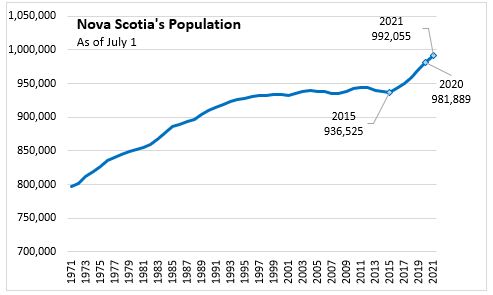
National population growth was 0.55 per cent from July 1, 2020 to July 1, 2021. The fastest growth was observed in Prince Edward Island while Newfoundland and Labrador was the only province with declining population. Population growth slowed in all provinces except Newfoundland and Labrador, where the pace of population decline slowed. Statistic Canada noted that nationally the pace of growth was the slowest since 1915/1916. COVID-19 related deaths partially contributed to the slower growth in Canada. Border restrictions significantly reduced international migration flows.
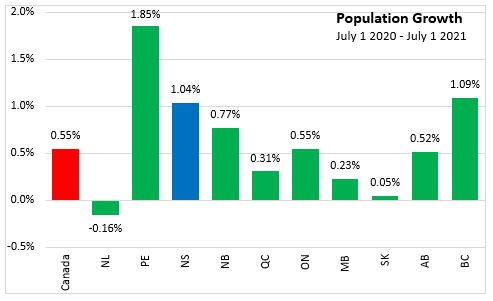
Last year's population increase of 10,166 was the third largest population growth (July 1 to July 1) since 1971 with the largest increasing occurring in 2018 and 2019.

In percentage terms, Nova Scotia's growth of 1.04 per cent was slower than the pace reported for 2018 and 2019.
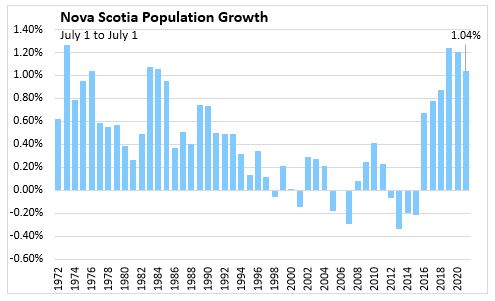
Nova Scotia's population grew last year as births, immigrants, net interprovincial migrants outpaced declines from deaths, emigration, and non-permanent residents.
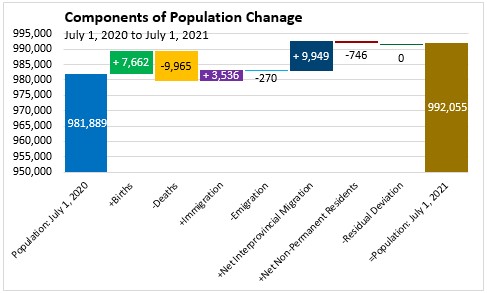
Natural population change (births less deaths) put continued downward pressure on Nova Scotia's population. From July 1, 2020 to July 1, 2021 there were 7,662 births and 9,965 deaths, resulting in a net natural population change of -2,303 over this period.

From July 1, 2020 to July 1, 2021, Nova Scotia reported 3,536 immigrants coming to the province. This was below levels from the past five years, but generally higher than during the 1990s and 2000s.
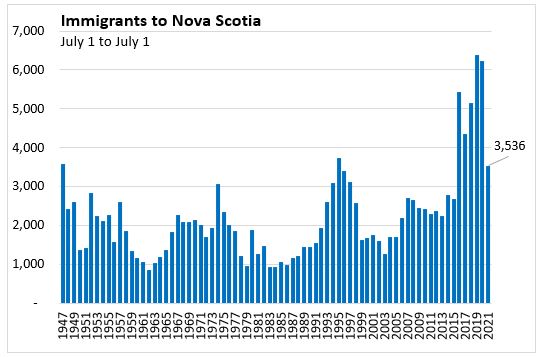
Net emigration was 270 persons moving from the province to another country between July 1, 2020 and July 1, 2021. The change in non-permanent residents (which includes students and temporary foreign workers) was a decline of 746 persons, the first decline since 2006/2007. Accounting for the decline in net emigration and net non-permanent residents, the net international population change for Nova Scotia was 2,520 over the last year.
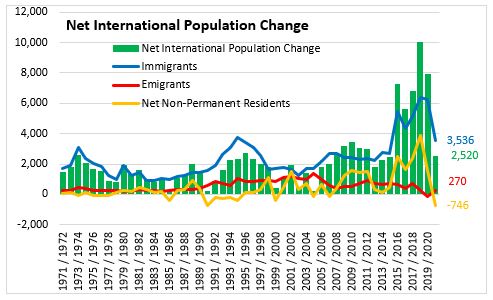
The period from July 1, 2020 to July 1, 2021 marked the sixth consecutive year of positive net interprovincial migration to Nova Scotia. The net increase of 9,949 in interprovincial movers is the largest amount back to 1971/1972. The number of in-migrants to Nova Scotia from other provinces rose to 20,484 while the number of out-migrants from Nova Scotia was down to 10,535.

There was net positive interprovincial migration across the age distribution. Net interprovincial migration of children (aged 0-14) contributed 1,226 to Nova Scotia's population from July 1, 2020 to July 1, 2021. Youth interprovincial migration (ages 15-34) was positive at +4,479 over this period. Youth are notably more mobile than other age cohorts. Net migration of those aged 35-49 was also positive at +1,635. The pace of net migration among aged 50-64 (+1,776) and 65 and over (+833) also increased relative to 2019/2020. Consistent across age groups, the number of in-migrants increased and the number of out-migrants decreased for 2020/2021.
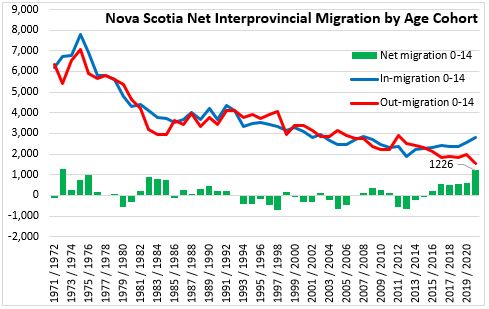

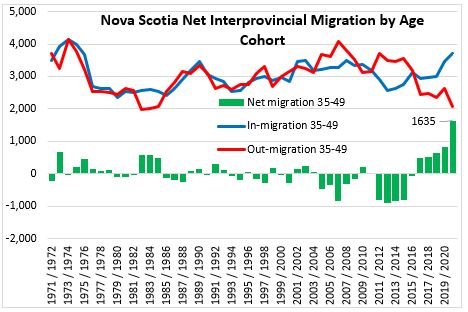
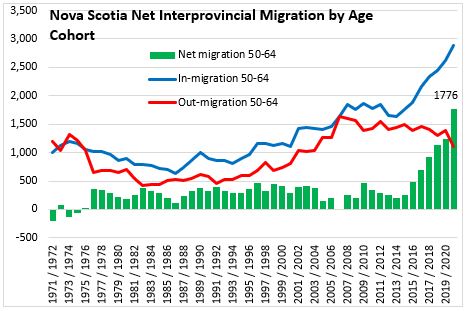
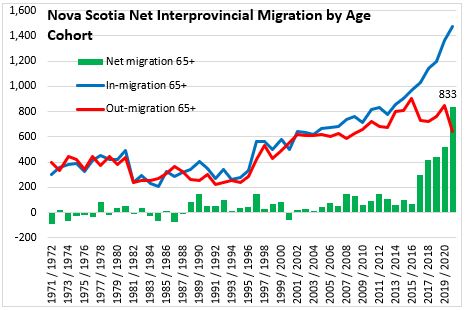
By source and destination, Nova Scotia's net interprovincial migration had positive contributions from all provinces and the territories. The largest sources of net interprovincial migration to Nova Scotia were Ontario (+6,354) and Alberta (+1,599). Ontario accounted for 64% of the net interprovincial migration increase in 2020/2021.
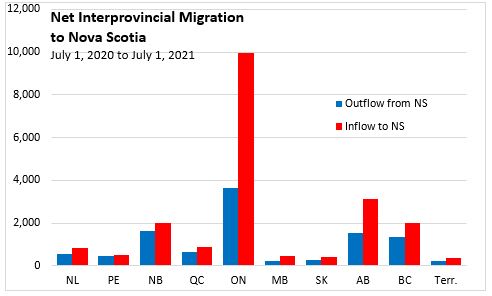
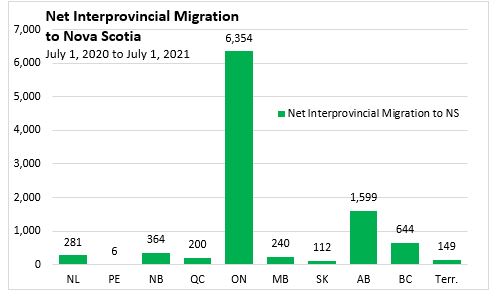
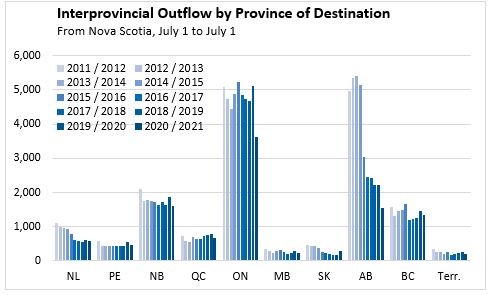
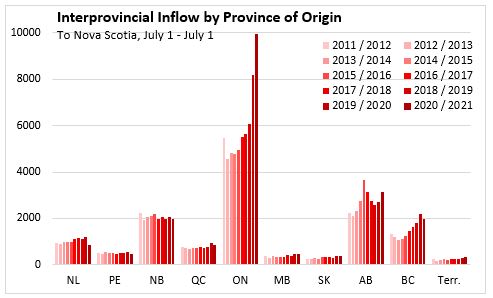
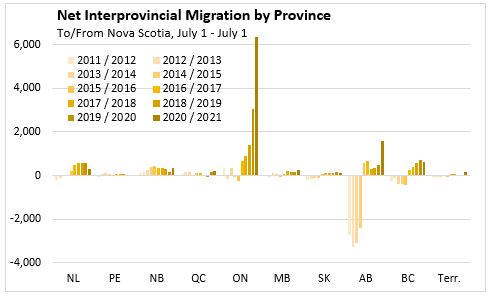
The median age in Nova Scotia increased 0.1 years to 45 years as of July 1 2021. The median age in the province has been around 45 years since 2015. Nova Scotia's median age is the third highest among the provinces. Newfoundland and Labrador (47.8) years is the highest and Manitoba (37.8 years) is the lowest.

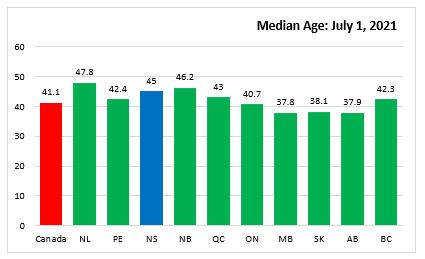
Immigration and net interprovincial migration have contributed to a reversal in declining populations of Nova Scotia's younger cohorts, particularly for those aged 18-39.

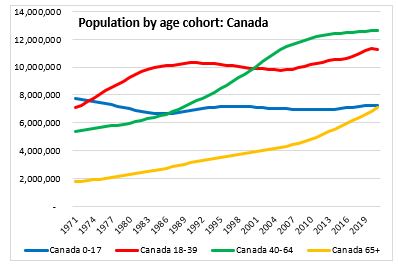
Source: Statistics Canada. Table 17-10-0005-01 Population estimates on July 1st, by age and sex, Table 17-10-0008-01 Estimates of the components of demographic growth, annual, Table 17-10-0014-01 Estimates of the components of international migration, by age and sex, annual, Table 17-10-0015-01 Estimates of the components of interprovincial migration, by age and sex, annual, Table 17-10-0022-01 Estimates of interprovincial migrants by province or territory of origin and destination, annual, Table 17-10-0009-01 Population estimates, quarterly, Table 17-10-0040-01 Estimates of the components of international migration, quarterly, Table 17-10-0020-01 Estimates of the components of interprovincial migration, quarterly
<--- Return to Archive